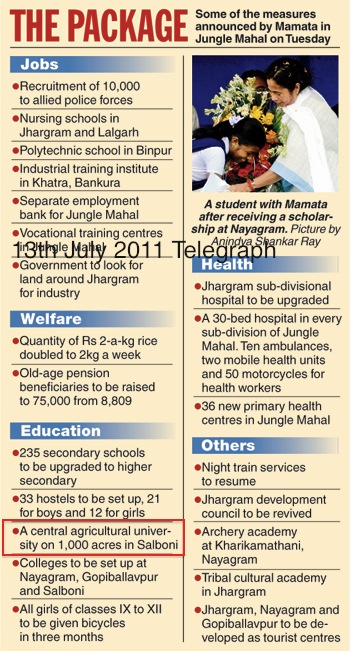Fifth anniversary of this site: We started with campaigning for a central university in KBK; Its time to campaign for a central agricultural university in KBK (especially Kalahandi)
Our first posting in this site was on November 28th, 2006. It is at https://www.orissalinks.com/archives/7. It was about a central university in KBK. We succeeded in our mission and a central university in KBK was announced in March 2008, and it has now been established in Koraput district.
Earlier this year (On May 22nd 2011) I wrote to the planning commission to establish a central agricultural university in Odisha as part of the 12th plan. Following are excerpts of my mail.
I propose that the 12th plan staring from 2012 include several Central Agricultural Universities in backward district clusters of India that have potential for agriculture.
Sirs and and Madams: One of the biggest achievement of the 11th plan was that the new institutions (16 central universities, 8 new IITs, 7 new IIMs, proposed 20 new IIITs, proposed 14 innovation universities) were located across India, in states ruled by UPA, in states not ruled by UPA, and so on. It was an inclusive distribution and less driven by political connections.
I request that similar distribution be made with respect to the institutions that are proposed for the 12th plan, starting with several central agricultural universities with various colleges (Agriculture, Horticulture, Veterinary, etc.).
The initial wave of creation of agricultural universities across India (in the 1960s) were an important factor in the initial Green revolution of India. However, as has been noted in the last two budgets (2010-11 and 2011-12) there is a need for another such revolution, especially taking into account factors such as (i) further mechanization (ii) urbanization (iii) looking east and (iv) developing backward and tribal areas.
In the 2010-11 budget speech ( http://indiabudget.nic.in/
ub2010-11/bs/speecha.htm ) the Finance Minister had said the following: 44. The agriculture sector occupies centre-stage in our resolve to promote inclusive growth, enhance rural incomes and sustain food security. To spur the growth in this sector, the Government intends to follow a four-pronged strategy covering (a) agricultural production; (b) reduction in wastage of produce;
(c) credit support to farmers; and (d) a thrust to the food processing sector.45. The first element of the strategy is to extend the green revolution to the eastern region of the country comprising Bihar, Chattisgarh, Jharkhand, Eastern UP, West Bengal and Orissa,…
In the 2011-12 budget speech ( http://indiabudget.nic.in/
bspeecha.asp ) he said the following: Bringing Green Revolution to Eastern Region52. The Green Revolution in Eastern Region is waiting to happen. To realize the potential of the region, last year’s initiative will be continued in 2011-12 with a further allocation of `400 crore. The program would target the improvement in the rice based cropping system of Assam, West Bengal, Orissa, Bihar, Jharkhand, Eastern Uttar Pradesh and Chhattisgarh
.Both speech say the green revolution needs to be extended to the eastern region. The allocation of a total of 400 crores to 7 states is miniscule for the purpose and does very little.
Hence, I request that this aspect of extending the green revolution to the eastern region be taken seriously and in the 12th plan Central Agricultural Universities be established in appropriate locations in these states and some of the other states of the country.
Somewhat of a start in this direction has been made via the allocation of 30 crores for a Central Agricultural University in Bundelkhand in the 2011-12 budget.
It was reported by the press that Mr. Rahul Gandhi lobbied for this.
I would like to thank him for his vision and initiative and humbly request the planning commission that they need to also think of the other backward areas of the country.
Taking all the above into account, it would be a win-win to include the establishment of several Central Agricultural Universities in the country located in backward districts with agriculture potential. The win-win aspects are:
(i) They will help higher education and GER, but will not stress the MHRD budget or its management. The majority of the funding could come from the Ministry of Agriculture with some required contributions from the state governments.
(ii) They will help bring in a new green revolution in some areas and extend the green revolution to the eastern region.
(iii) Since there have not been many new agricultural universities across the country, it will be comparatively easier to recruit faculty for these new institutions.
(iv) By locating them in the backward district clusters, they will bring Bharat and India closer.
I had sent copies of my mail to the MPs of Odisha as well as the Chief Minister’s officer. I talked to the secretary of agriculture Ranglal Jamunda by email at agrsec.or@nic.in as well as by phone and urged him that the Odisha government must push for a central agricultural university in Odisha, especially in the KBK regions (in particular, Kalahandi, as Kalahandi is known to be one of the rice bowl of Odisha; and Kalahandi was skipped over when deciding on the location of the central university in Koraput).
My emails and phone calls has had no visible impact on Odisha government, Odisha officials or Odisha MPs as so far I have not read any news regarding Odisha pursuing a central agricultural university. However, the news of the West Bengal government pursuing a central agricultural university came out after a few days of my writing to the planning commission. It is possible that may mail to the planning commission somehow got forwarded to the right people in West Bengal or it may just be a pure coincidence. Following is from a Telegraph article on 13th July 2011.

I think there is still time to pursue to get this included in the 12th plan. I request all readers to write to the Chief Minister’s office at cmo@ori.nic.in regarding this.
Sincerely,
Chitta Baral
11 comments November 29th, 2011